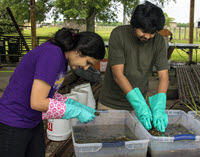
Devika and Chinmay Tikhe floating tabanid larvae out of marsh sediments. (Photo by Claudia Husseneder)
Greenhead horse fly larvae are the top invertebrate predator in the Spartinamarshes along the Gulf of Mexico coastline. Adult and larval horseflies exhibited reduced genetic variation and population declines in oiled marshes after the Deepwater Horizon oil spill, which suggests that these organisms could be an indicator species for post-spill marsh health. Devika Bhalerao uses DNA analyses to identify organisms important to the larvae’s survival and determine if oiling alters the presence of various organisms in the food web. Her findings will help develop analytical tools that ecologists can use to evaluate the health of tidal marshes.
Devika is an entomology master’s student at Louisiana State University (LSU) and a GoMRI Scholar with the GoMRI-funded project A Study of Horse Fly (Tabanidae) Populations and Their Food Web Dynamics as Indicators of the Effects of Environmental Stress on Coastal Marsh Health led by Lane Foil and Claudia Husseneder.
Her Path

Devika Bhalerao. (Photo by Claudia Husseneder)
Devika’s love for biology began when her mother taught biology to local children in Devika’s childhood home of India. Devika discovered a more focused interest in molecular biology and genomic research while studying as a microbiology undergraduate student at Pune University in India. She gained more genomics experience through the Pune University microbiology master’s program where she used metagenomics to decode the microbiome of the rural Indian population.
Devika attended a presentation about using metagenomics in insect systems given by Chinmay Tikhe, a Ph.D. student in Dr. Claudia Husseneder’s LSU Agricultural Center lab. She contacted Husseneder to learn more about their project and the use of metagenomics to describe the food web of horsefly larvae in Louisiana marshes. “The prospect of using the latest techniques such as next-generation sequencing and metagenomics bioinformatics to figure out how the marsh ecosystem functioned made me excited about this research,” she said. Devika joined the Husseneder lab in spring 2015 as an entomology master’s student.
Her Work
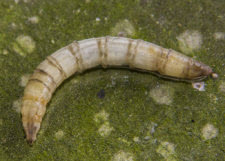
A greenhead horse fly larva. (Photo by Claudia Husseneder)
Devika analyzes the greenhead horse fly larval food web to identify organisms in marsh soil that are important for sustaining this top invertebrate predator. She extracts DNA from the larvae’s gut contents and the surrounding sediments from oiled and unoiled marshes and multiplies a specific DNA region called the 18SrRNA gene using the polymerase chain reaction (PCR) amplification technique. She then applies next-generation sequencing to the 18SrRNA gene and compares the resulting sequences to a gene database to identify the organisms present in the gut contents and sediment. This information helps her analyze which organisms in the marsh soil are important for sustaining the greenhead horse fly larvae.
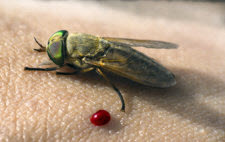
An adult greenhead horse fly. (Photo by Claudia Husseneder)
Devika’s research has shown that most species that are present in the larvae’s gut contents belong to insect and fungi families. Her next steps will compare food webs from oiled and unoiled areas to identify if any food web components are missing from oiled marshes. She and her colleagues will use the bioindicators that she identifies to develop a cost-efficient and user-friendly PCR tool capable of determining marsh health.
“My research is the first study of an apex invertebrate predator food web in coastal Spartina marshes with the purpose of identifying the food web’s key elements,” said Devika. “Since greenhead horse flies are associated with Spartina marshes spanning from Texas to Nova Scotia, this study could develop techniques that can monitor the health of coastal marshes across the entire eastern United States.”
Her Learning
Working in Husseneder’s lab taught Devika how difficult it can be to collect larvae in the field. The collection process requires the entire team to devote considerable amounts of time, diligence, and patience to processing many buckets of sediment for only a few larvae. She considers attending the 2017 Benthic Invertebrates, Metagenomics, and Bioinformatics (BITMaB) workshop organized by GoMRI researcher Dr. Kelley Thomas to be the greatest advantage she experienced as a member of the GoMRI scientific community. “The workshop was a game changer in my research,” she said. “I could use the techniques I learned at the workshop to conduct the bioinformatics of my study myself. In my pursuit to acquire advanced molecular techniques, learning to use Quantitative Insights into Microbial Ecology (QIIME) techniques was the cherry on the cake.”
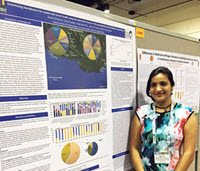
Devika standing by her poster at an entomology conference. (Provided by Claudia Husseneder)
Devika has won several awards for her poster and oral presentations, including the 2016 International Congress of Entomology’s Graduate Student Poster Competition award for ecology and population dynamics and a travel award for the LSU Coastal Connections Competition. “The presentation that won me the travel award was extremely challenging, because I had to explain my entire research in three minutes in layman’s terms using only two slides without animation,” she said. She also won the Outstanding Masters Oral Presentation Competition at the 2017 Annual Meeting of the Southeastern Branch of the Entomological Society of America. “This award was memorable because later at an informal meeting one of the judges commended me on my presentation and said that it stood out,” recalls Devika.
Her Future
Devika plans to pursue a Ph.D. program that uses her molecular biology skills. She advises students considering a career in science to find ways to expand their skill sets. “Keep updating your current skill set and acquiring new skills in your field and stay abreast of the latest research in fields besides your own,” she said. “It can open avenues to apply your skill sets in new systems.”
Praise for Devika
Husseneder described Devika as a bright and dedicated student with a knack for figuring things out – a perfect fit for a project handling massive amounts of data and statistics. Even after the BITMaB workshop ended, Devika continued teaching herself how to use the complex statistics associated with environmental metagenomics, which she shares with students from other departments. She also teaches undergraduate students and fellow graduate students how to use DNA sequencing to identify arthropods found in marshes. “Devika is an invaluable part of our team,” said Husseneder.
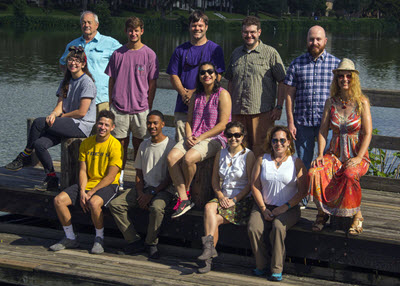
Devika (middle row, center) and Husseneder (middle row, far right) pose for a group photo with their research team. (Photo by Claudia Husseneder)
The GoMRI community embraces bright and dedicated students like Devika Bhalerao and their important contributions. The GoMRI Scholars Program recognizes graduate students whose work focuses on GoMRI-funded projects and builds community for the next generation of ocean science professionals.
************
The Gulf of Mexico Research Initiative (GoMRI) is a 10-year independent research program established to study the effect, and the potential associated impact, of hydrocarbon releases on the environment and public health, as well as to develop improved spill mitigation, oil detection, characterization and remediation technologies. An independent and academic 20-member Research Board makes the funding and research direction decisions to ensure the intellectual quality, effectiveness and academic independence of the GoMRI research. All research data, findings and publications will be made publicly available. The program was established through a $500 million financial commitment from BP. For more information, visit http://gulfresearchinitiative.org/.
© Copyright 2010- 2017 Gulf of Mexico Research Initiative (GoMRI) – All Rights Reserved. Redistribution is encouraged with acknowledgement to the Gulf of Mexico Research Initiative (GoMRI). Please credit images and/or videos as done in each article. Questions? Contact web-content editor Nilde “Maggie” Dannreuther, Northern Gulf Institute, Mississippi State University (maggied@ngi.msstate.edu).
